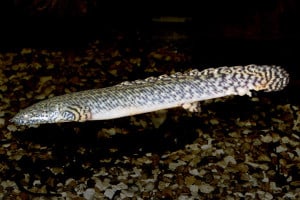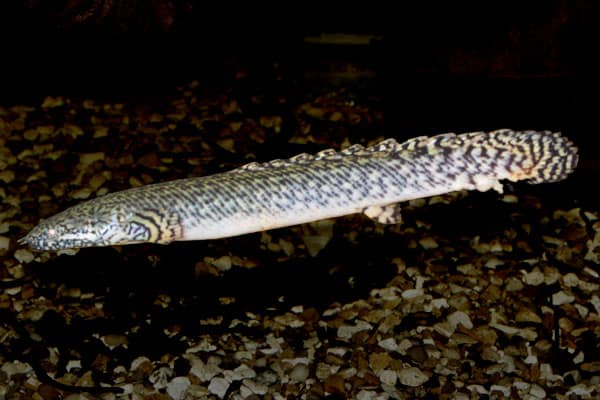
Common name: Ornate Bichir
Scientific name: Polypterus Ornatipinnis
Average Adult Fish Size: 25 inches / 63.5 cm
Place of Origin: Congo River, Lake Tanganyika, and Lake Rukwa, Africa
Typical Tank setup: A well decorated aquarium with well rooted and over hanging plants is appreciated as Bichirs are mainly nocturnal and do not like bright lighting. The base of the plants need to be protected by rockwork though, other wise a large bichir will eventually uproot and destroy them. Offer plenty of caves in the form of rockwork and bog/wood/driftwood along with medium to medium-fine sand or gravel as a substrate.
Recommended Minimum Aquarium Capacity: Juveniles can easily be kept in aquariums as small as a 20 gallon /80 litre, but full grown adults need an aquarium with large base dimensions measuring at least 6 feet x 2.5 feet / 180 cm x 75 cm , or 250 gallon / 1000 litre. Depth is not as important as “floor space”.
Compatibility: All Bichirs are relatively peaceful with other fish that are too large too eat. They will eat others of their own kind given the chance though, so other Bichir tankmates should be close to the same size. Sometimes Bichirs will squabble among themselves over food, but rarely is any damage done.
Temperature: 77 – 83 Deg F / 26 – 28 Deg C
Water chemistry: pH 6.0 – 8.0
Feeding: Bichirs are carnivorous so feed meaty type foods consisting of good quality pellets of the appropriate size, sticks, chunks of frozen foods like brine shrimp, mysis shrimp, or beef heart along with chopped market shrimp, chunks of raw fish, blood worms, black worms, and earthworms.
Sexing: Males have a large pocket like anal fin which is thicker than the females.
Breeding: Can be breed in aquarium however breeding is very rare. Polypterus Ornatipinnis scatter their eggs and leave their young to fend for them self.
Additional Information: Ornate Bichirs are, considered by some, to be the most beautiful of the Bichirs. Their pattern tends to fade and blend as they grow, so try to find juveniles with distinct coloration, as they will maintain their pattern longer. Always make sure the aquarium is tightly covered with no open holes or means of escape. Bichirs are messy eaters, so provide good filtration and frequent partial water changes to maintain good water quality. Even though they are bottom dwellers, they must be able to surface when they feel like it. This is because they breathe oxygen from the air as well. Always ensure that your Bichir has enough room to go up for a fresh breath of air.


Related Posts
Croaking Gourami – Trichopsis vittatus
Benthochromis Tricoti
Large-eyed Mouthbrooder – Callochromis Macrops